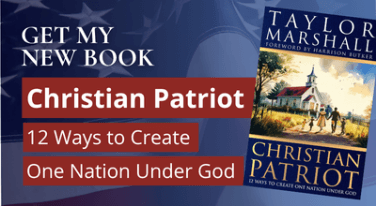The Four Horsemen of the Apocalypse – Coming to a Nation Near You
One of the great film quotes comes from Tombstone when Johnny Ringo quotes the Apocalypse “Behold the pale horse. The man who sat on him was Death… and Hell followed with him.”
A clever line, but what’s the story of the biblical Four Horseman, the last of which is named “Death”? Who are they and what do they signify?
The Four Horsemen of the book of Revelation are summoned as the “seven seals” are opened by the Lamb of God who is our Lord Jesus Christ (Rev 6:1-8).
Here are the details of each of the four horsemen:
- White Horse symbolizing Conquest
- Red Horse symbolizing War
- Black Horse symbolizing Famine
- Pale Horse symbolizing Death
White Horseman
Saint Irenaeus interpreted the four horseman as righteous. He even taught that the White Horseman was Christ Himself riding out in victory over the world with the Gospel of salvation. The appearance of Christ on a white horse in Revelation 19 seems to confirm this interpretation – I certainly hold this view. This, then, would signify that the “Conquest” is the spiritual conquest of Christ over the hearts of mankind. It is the extension of the Great Commission.
Red Horseman
The rider of the second red (πυρρός, from πῦρ, fire) horse represents War. This indicates a universal war, or perhaps the martyrdom of Christians. If this is past, it represents the Roman persecutions. If it is future, it represents the great persecution after the “fullness of the Gentiles” come into the Church.
Black Horseman
The Black Horseman signifies a food famine. This is the most interesting of the four horseman. Here the means of exchange is silver – i.e. the actual metal. Paper money or currency isn’t be used. Moreover, the price for wheat and barley is inflated beyond the means of a day laborer. The idea is that people will not be able to purchase food. Now, the angel says that “see thou hurt not the oil and the wine.” This means that the luxury of oil and wine will not be penalized. It’s rather odd. Daily staples (bread) will inflate in price, but luxury items (wine and oil) will not inflate. The really interesting thing is that all three items (bread, wine, and oil) are the three elements used in Catholic sacraments. So perhaps the saving of wine and oil is a reference to the fact that the Church will be able to retain her sacraments. That’s just a guess. I cannot really back this up with any Fathers – so take it or leave it.
Pale Horseman
The fourth and last horseman is named Death. The color of his horse is written as khlōros (χλωρός) in the Greek, which often refers to the color green. This why green represented death and the devil during the Middle Ages, by the way.
I look forward to any other thoughts or insights – especially about the wine and oil of the Black Horseman.
What to Watch Next
SHOP THE TAYLOR MARSHALL STORE
Dive Deeper

GET CONFIDENT IN YOUR FAITH
Explore the fascinating world of Catholic teachings with Dr. Marshall. Together you’ll unpack the brilliant answers the Church gives to tough questions about the Faith. The best part: you go at your own pace. Start this exciting journey today.


 >
>




